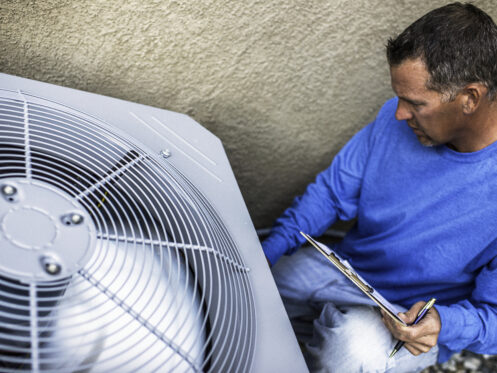With summer temperatures in Fort Mill, SC often climbing as high as 90 degrees Fahrenheit, you need a functional air conditioner. Fortunately, when cooling problems arise, there are often quick and easy ways to resolve them. With the AC troubleshooting guide that follows, you may be able to sidestep the need for professional repairs.
Understand the Difference Between Troubleshooting and Repairs
Before troubleshooting your AC, it’s important to understand the difference between troubleshooting and repairing. Air conditioners are hardwired into residential electrical systems. Thus, do-it-yourself AC repairs can be dangerous. All air conditioners also contain refrigerants like Opteon and Puron that should only be handled by experienced technicians. DIY AC repairs can additionally void important warranty protections.
Troubleshooting is a series of basic steps that homeowners can safely take to optimize operating conditions. Repairing an air conditioner frequently involves opening equipment housing and tampering with moving components. If your air conditioner doesn’t respond to basic troubleshooting measures, it’s time to call a professional.
Check Your HVAC Air Filter
All of the air that enters your AC passes through its filter. This component sieves out dirt and other particulates to keep your air conditioner’s internal components protected. If it’s covered in a thick layer of lint-like debris, your AC could short cycle, overheat, or develop frost on its coils. If your air filter is dirty, replace it and then wait 15 to 30 minutes for your air conditioner to defrost or cool down.
To avoid filter-related problems, be sure to inspect this component once each month. According to HVAC equipment manufacturers, homeowners should replace standard air filters once every 30 to 90 days.
Check Your Thermostat’s Setting
Make sure that your thermostat’s temperature setting is lower than the current temperature of your home. There’s always the chance that someone in your household felt too cold and cranked your thermostat up when you weren’t looking.
Most thermostats have “OFF”, “FAN”, and “AUTO” settings. When thermostats are set to “FAN”, HVAC fans run non-stop but air conditioners never initiate cooling cycles. This could be the problem if your air conditioner is running but only putting out lukewarm air. Make sure that your thermostat is set to “AUTO” instead.
Clear the Area Around Your AC’s Outdoor Condenser Unit
There may be airflow problems at your air conditioner’s outdoor condenser. When your air conditioner extracts heat, it releases it outside via the condenser. Installed in back or side yards, AC condensers are sometimes encroached upon by fast-growing grass, shrubs, trees, and other living landscape elements. Condensers can also get blocked by nests, animals, and windblown leaves and twigs. When air conditioners can’t release the heat that they’ve extracted, they’ll eventually overheat and shut down.
Your AC condenser should have 2 feet of clearance on all sides at all times. Remove build-ups of leaves, twigs, and other debris, and trim back all nearby foliage. You should also make sure that no one in your household is using your AC condenser to prop up tools, equipment, toys, or other personal items.
Look for HVAC Air Vent Closures
Closing HVAC air vents might seem like a good way to redirect cool air when you no longer want it but doing so can actually cause major AC performance issues. Central cooling systems are designed to cool all building areas uniformly. Without professional zoning, they don’t have a way to get rid of unwanted air and the resulting static pressure. Closing too many vents and keeping them closed creates a dramatic rise in in-duct pressure that inhibits airflow. This increase could cause your AC to shut down, short cycle, or underperform.
If you have closed HVAC air vents throughout your home, open them up. You should also consider scheduling air-balancing services so that our team can optimize all vent positions.
Clean Dirty HVAC Air Vents
Build-ups of the same lint-like material that form on HVAC air filters could exist on or behind your air vent covers. If you have consistently low indoor air quality or if you regularly skip or delay filter changes, be sure to wipe these features down. You can also take the vent covers off and vacuum just behind them.
Reset Your Air Conditioner’s Circuit Breaker
If your air conditioner won’t turn on, check for a tripped circuit breaker. You can reset your AC’s circuit breaker by first pushing it all the way into the “OFF” position and then toggling back on. However, if the breaker immediately trips again, schedule professional repairs right away.
We help homeowners in Fort Mill, SC maintain cool, comfortable homes. We offer exceptional heating and cooling services. We also provide cutting-edge indoor air quality improvements, duct cleaning, new ductwork, and thermostat repairs. Contact Arce Heating & AC today to find out about our HVAC preventative maintenance plans or schedule an appointment.
